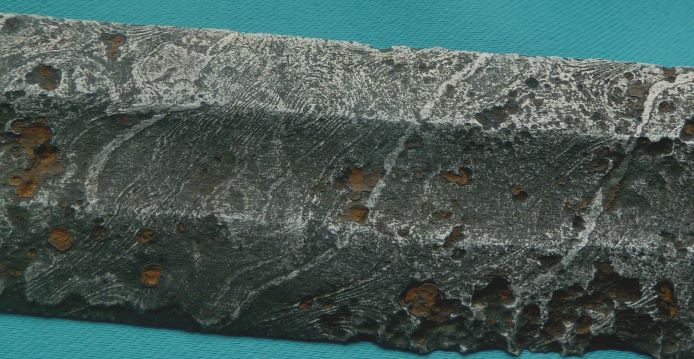Posts: 4 Location: United States
Fri 30 Nov, 2018 2:44 pm
Thoughts on Viking Age Blade
Hello,
I'm currently looking at a supposedly Viking Age sword blade. Images attached. I wanted to get the forum's thoughts on authenticity. I'm new to collecting and I have to start somewhere, but I've been astounded by the number of complete and composite fakes in circulation, even at the major auction houses.
[ Linked Image ]
 Attachment: 66.99 KB
Attachment: 66.99 KB

 Attachment: 45.51 KB
Attachment: 45.51 KB
[ Download ]
Posts: 256 Location: London, UK
Fri 30 Nov, 2018 3:52 pm
My gut feeling (although I'm not a huge expert here) is that this is modern mass-produced 'damascus'/pattern-welded steel, ground to shape and artificially aged. The particular pattern feels like the result of making a very large billet with a power hammer and then cutting sections to make blades from, which isn't how Viking-era swords would have been made. In addition, the pattern goes right to the edge, but generally pattern-welded swords from this period have separate edges attached to the core of the blade.
Posts: 4 Location: United States
Fri 30 Nov, 2018 4:06 pm
Interesting. Thank you for the input. I had the general feeling without specific knowledge about the process that you handily described!
I've only seen one edge-to-edge pattern-welded Viking age sword in the literature: the Met Sword. But the Met doesn't have high enough resolution images to see the edge pattern welds and, regardless, it doesn't look like this sword.
Posts: 256 Location: London, UK
Fri 30 Nov, 2018 5:17 pm
Here's a couple of random
modern examples off eBay. Both show the same sort of wide twist pattern, although the blade grind on the example you've posted seems more reasonable. What you can see straight away is how the blade has been made from a piece of steel that was twisted and shaped as a single unit - the diagonal stripes are where twists were put into the billet.
Posts: 1,606 Location: Chicago, Illinois
Fri 30 Nov, 2018 8:36 pm
I agree about the pattern. It’s not a historical technique at all. Do you have pictures of the sword in its entirety? Also, does the blade have
distal taper? Real swords would have this feature. A pic of the blade side on would help determine it....
Posts: 17 Location: Flanders
Sat 01 Dec, 2018 7:10 am
If this would be real, it would be in a remarkable state of preservation.
Lots of Viking swords have been found but few of them are in this condition.
Posts: 4 Location: United States
Tue 04 Dec, 2018 3:00 pm
Thank you to all who replied for your help. I think I'm letting my desire to purchase an interesting sword put blinders on my judgment. The hilt is very historical looking and reminiscent of the Ljudota Sword, which also helped me ignore the problems with the blade.
I also couldn't find this type of pattern in any of the literature. And, after further research, I found 38" damascene billets on Alibaba. The length of this sword and the swords Mr. Kew posted? 38".
My search continues! And if anyone has a bridge in Brooklyn they're looking to sell in the meantime, then I'm obviously your man!
Posts: 14 Location: CZ
Mon 10 Dec, 2018 8:19 am
Has there ever been a viking age sword found where the pattern would be uninterrupted from the core all the way to the outer edge? It seems to defy my understanding of the purpose of pattern welding.
I have always thought you would have a soft & hard core (the mixture of soft and hard causing the pattern) and then you would have the hard edges welded onto the core, which means you have (at least) two different patterns, one at the edges and the other (more or less) in the fuller.
In this case it would seem that the part of the pattern which is made of the soft iron extends to the cutting edge which should mean an edge which is soft in places and hard in others.
Please correct me if I´m wrong.
Thank you.
Posts: 8,310 Location: Montreal,Quebec,Canada
Mon 10 Dec, 2018 9:14 pm
| Will L. wrote: |
Thank you to all who replied for your help. I think I'm letting my desire to purchase an interesting sword put blinders on my judgment. The hilt is very historical looking and reminiscent of the Ljudota Sword, which also helped me ignore the problems with the blade.
I also couldn't find this type of pattern in any of the literature. And, after further research, I found 38" damascene billets on Alibaba. The length of this sword and the swords Mr. Kew posted? 38".
My search continues! And if anyone has a bridge in Brooklyn they're looking to sell in the meantime, then I'm obviously your man! |
If an authentic Viking sword with a relatively well preserved blade I would think that the asking price would be astronomical, if it's only a few thousand dollars or even less it's probably a fake.
Now this is what one pattern welded Viking sword might look like when new. ( There are other patterns for the centre part of the blade ).
https://www.youtube.com/watch?v=VY9rT2mMr3s
https://www.google.com/search?client=safari&rls=en&q=pattern+welded+saxon+sword&ie=UTF-8&oe=UTF-8
This shows what the original patterns would look like:
https://www.google.com/search?q=pattern+welded+saxon+sword&client=safari&rls=en&tbm=isch&source=iu&ictx=1&fir=bbOOLWuLH5yWiM%253A%252C_wHYKG4cLx1nKM%252C_&usg=AI4_-kRGR6nlRC_UzlHu39WgmxgaJGc2Rw&sa=X&ved=2ahUKEwimpp20gpffAhWvUt8KHVCaAmcQ9QEwCXoECAQQFg#imgrc=bbOOLWuLH5yWiM:
You
cannot post new topics in this forum
You
cannot reply to topics in this forum
You
cannot edit your posts in this forum
You
cannot delete your posts in this forum
You
cannot vote in polls in this forum
You
cannot attach files in this forum
You
can download files in this forum
